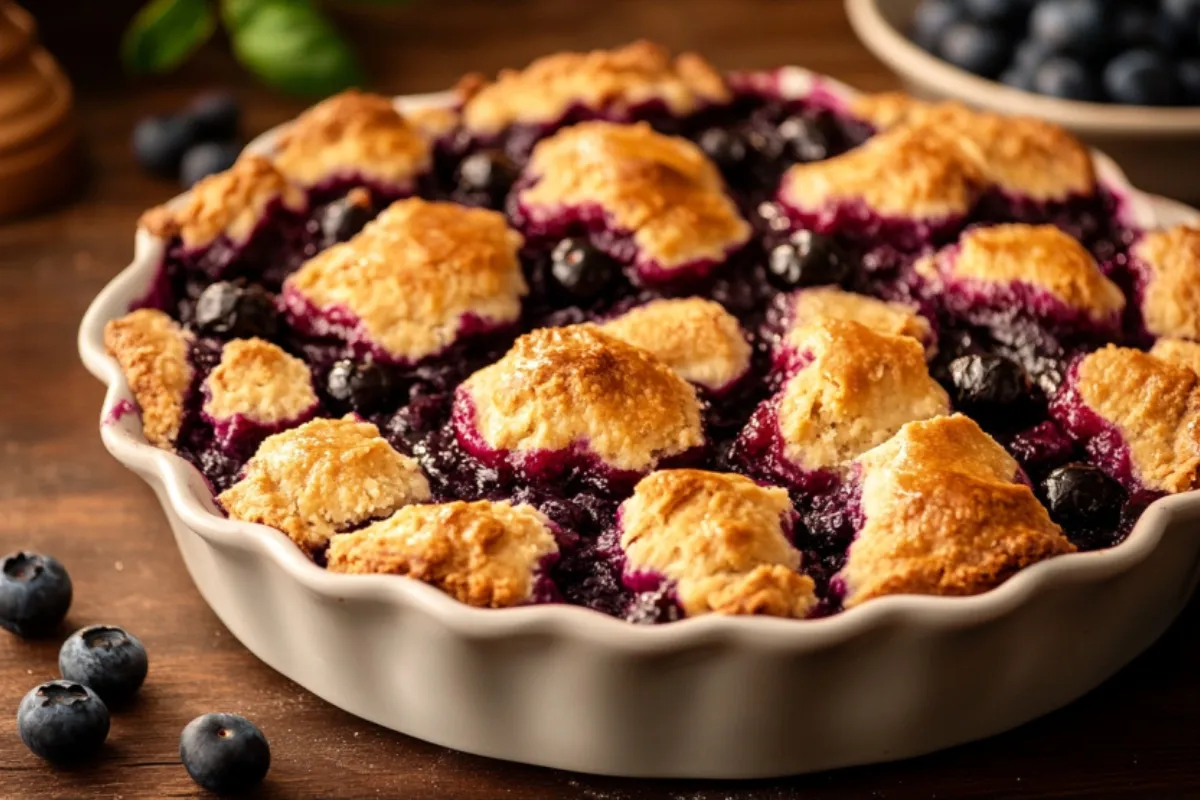What is Blueberry Cobbler?
Blueberry cobbler is a warm, comforting dessert that features sweet, tangy blueberries paired with a biscuit-like topping. It’s an easy-to-make dish that offers a delightful balance between fruit and dough. Often served with a scoop of vanilla ice cream or a dollop of whipped cream, blueberry cobbler is the epitome of a perfect summer treat. While blueberries are the star of the dish, you can also find variations with other fruits, such as peaches, cherries, or mixed berries.
The texture of a classic cobbler is a combination of tender fruit and a slightly crispy, golden top, making it a perfect dessert for any occasion, whether it’s a family gathering, holiday dinner, or just a sweet treat to enjoy after a meal.
The Origins and Popularity of Blueberry Cobbler
The history of blueberry cobbler, like many classic American desserts, is tied to the simple pleasures of home cooking. It is believed that cobblers originated in early American colonial kitchens when fruit was baked under a layer of biscuit dough, often as a way to stretch the use of ingredients in the absence of more traditional pie crusts. The fruit-filled dessert grew in popularity, especially in regions where blueberries thrived, making blueberry cobbler a go-to recipe in areas such as the Northeast and Pacific Northwest.
Over the years, cobblers became a staple in American kitchens, appreciated for their ease of preparation and comforting, rustic charm. Blueberries, being readily available in many parts of the United States, became a popular choice for cobbler, and it has since become an iconic dessert.
How Blueberry Cobbler Became a Classic Dessert
Blueberry cobbler gained momentum in the 19th century and became a fixture at family meals and special occasions. Its rise to prominence was helped by the blueberry harvests, particularly in the northern states, which made the fruit widely available. The dessert’s simplicity, requiring just a handful of ingredients, made it accessible to many home cooks, especially during the summer when blueberries were in season.
Cobbler, in general, is often seen as a quintessential American dessert—easy to prepare and perfect for feeding a crowd. Over time, blueberry cobbler evolved into a beloved classic, often gracing tables at barbecues, picnics, and holiday dinners, where the natural sweetness of the blueberries shines through in the dish.
Why Blueberry Cobbler is a Favorite Dessert
The Sweet and Tangy Flavor of Blueberry Cobbler
The combination of sweet and tangy flavors in blueberry cobbler is what makes it so irresistible. The juicy blueberries burst with flavor as they cook, releasing their natural sweetness while maintaining a hint of tartness. The topping, often made with flour, butter, and sugar, provides a contrast of textures—crispy on the outside and soft on the inside. Together, the flavors and textures create a harmonious dessert that appeals to both fruit lovers and those who enjoy a more doughy, comforting finish.
Blueberry Cobbler’s Appeal in Summer Desserts
Blueberries are synonymous with summer, and their naturally sweet, refreshing taste makes them an ideal fruit for summer desserts. Blueberry cobbler is often served warm, making it a perfect treat for those cooler summer evenings. The freshness of the berries and the comfort of the warm topping bring a nostalgic, homey feel to any summer gathering.
The simplicity of the dish—just a few key ingredients—makes it an easy choice for any dessert table. Whether served at a barbecue, picnic, or family dinner, blueberry cobbler is guaranteed to be a crowd-pleaser. And since it’s so easy to make, it’s a go-to option when you need a quick, delicious dessert without spending hours in the kitchen.
Variations of Blueberry Cobbler Around the World
While blueberry cobbler is most commonly associated with American cuisine, variations of fruit-based cobblers can be found worldwide. In the United Kingdom, a similar dessert is known as a crumble, where fruit is topped with a buttery, sugary mixture, though it’s often more crumbly than the biscuit-like topping found in traditional cobbler.
In Australia and New Zealand, a similar dessert known as “crumble” is also popular, where the topping is often made with oats or ground nuts. Although the recipe may differ slightly, the fundamental idea remains the same: a warm, fruity dessert with a comforting, crisp topping.
In some European countries, cobbler-style desserts are often served as rustic tarts or pies, with fruit fillings encased in a traditional pie crust or shortcrust pastry. These variations still highlight the love for fruit-filled desserts that balance the sweetness of the fruit with a rich, hearty topping.
What is the Difference Between Blueberry Crumble and Blueberry Cobbler?
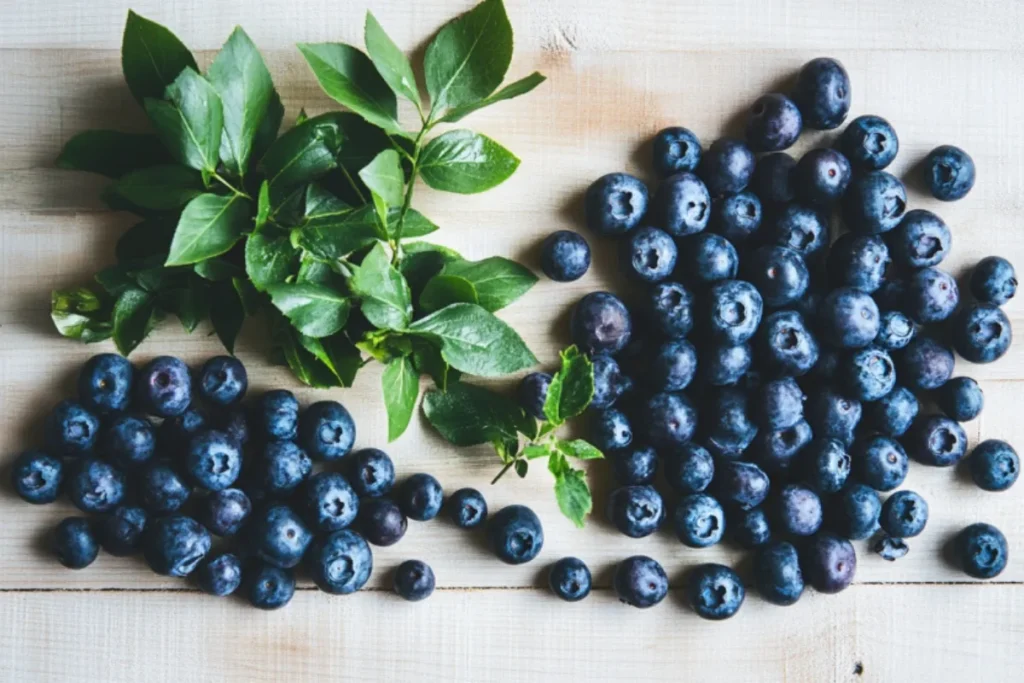
Comparing the Toppings of Cobbler and Crumble
The main difference between blueberry crumble and blueberry cobbler lies in the topping. In a blueberry crumble, the topping is typically made from a mixture of butter, sugar, flour, and oats, creating a crumbly texture that is slightly more uneven than the doughy topping of a cobbler. The crumble topping is spread evenly over the fruit filling and forms a crispy, granular texture when baked.
In contrast, the topping for blueberry cobbler is typically a biscuit-like dough that is dropped onto the fruit filling in spoonfuls, resulting in a more substantial, cake-like or biscuit-like consistency. The biscuit dough can range from light and fluffy to more dense, depending on the recipe, but it doesn’t create the same crumble-like texture.
If you enjoy fruit-based desserts, you might also like Apple Cheesecake Tacos: The Best Dessert Tacos. They offer a fun twist on traditional fruit desserts, perfect for those who love fresh fruit with a creamy finish.
Texture Differences Between Cobbler and Crumble
When it comes to texture, a cobbler often has a more structured topping compared to the looser, crumbly topping of a crumble. The biscuit-style topping of cobbler creates a soft, fluffy bite that contrasts nicely with the soft fruit below, while the crumble topping tends to be more crunchy and sandy in texture.
Another texture difference lies in the fruit filling. Both cobbler and crumble feature fruit that becomes soft and juicy as it bakes, but the cobbler topping generally provides more of a barrier, while the crumble topping often integrates more directly with the fruit, forming an almost combined layer.
Which Dessert is More Popular: Cobbler or Crumble?
While both cobbler and crumble are beloved in their own right, cobbler tends to be a more popular choice in the United States due to its versatility and comforting nature. Cobblers are often associated with American summer gatherings, barbecues, and holiday meals, making them a classic choice for family-style servings.
However, crumble enjoys widespread popularity in other parts of the world, particularly in the UK, where it is often served with custard or whipped cream. The simplicity of the crumble topping makes it a quick and easy dessert option, and it can easily be made with different types of fruits, such as apples, pears, or stone fruits.
In the end, the choice between cobbler and crumble often comes down to texture preference and the type of dessert experience you’re looking for.
What is the Difference Between Apple Cobbler and Apple Crumble?
How the Base and Topping Differ Between Cobbler and Crumble
Both apple cobbler and apple crumble feature a delicious fruit base, but their toppings differ significantly. In apple cobbler, the topping is typically a biscuit-like dough or batter that is spooned or dropped onto the apples before baking. The dough bakes into soft, pillowy lumps, creating a hearty contrast with the tender apples.
On the other hand, apple crumble features a crunchy topping made from a mix of butter, sugar, flour, and sometimes oats or ground nuts. The crumble topping is spread over the apples and bakes to create a crisp, crumbly texture.
Popular Ingredients Used in Apple Cobbler and Apple Crumble
Apple cobbler generally uses flour, butter, and sugar to create its biscuit-style topping, sometimes enhanced with milk or cream to add richness. The apples are usually combined with sugar, cinnamon, and lemon juice to create a flavorful filling.
For apple crumble, the topping typically includes butter, flour, sugar, and oats for a heartier, more crumbly texture. The fruit filling is similar, using apples and flavorings like cinnamon and nutmeg, though some recipes might call for a hint of ginger or cloves to add depth to the flavor.
Preparing Blueberry Cobbler
Is Cobbler Dough the Same as Pie Crust?
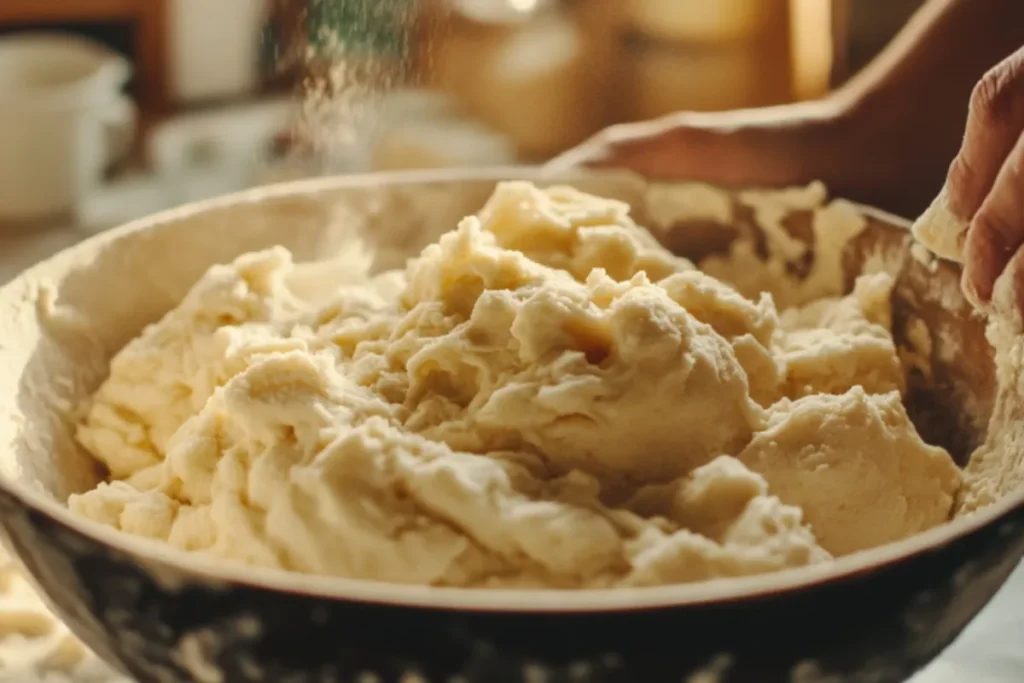
Many people wonder if cobbler dough is the same as pie crust since both are used to top fruit desserts, but there are some key differences in both texture and preparation. While pie crust is traditionally made with flour, butter, water, and sometimes salt to form a flaky, thin, and crisp layer, cobbler dough is generally thicker and more biscuity in texture.
Cobbler dough tends to use baking powder as a leavening agent, which causes the dough to rise slightly and form a biscuit-like texture. It is also drop-style, meaning the dough is spooned or dropped onto the fruit rather than rolled out and placed in a precise layer, as you would with a pie crust.
For those looking for a flakier, crispier alternative, Butter Swim Biscuits are an excellent choice. These biscuits are buttery and flaky, much like a pie crust, and can be served alongside a variety of fruit-based desserts, including cobblers.
Understanding the Key Differences Between Cobbler Dough and Pie Crust
The difference between cobbler dough and pie crust also lies in their respective uses. Pie crusts are usually used for both the bottom and top layers of a pie, whereas cobbler dough is primarily used as a topping for fruit fillings. The texture of pie crusts is meant to be flaky and tender, whereas cobbler dough is thicker and more rustic. Cobbler dough allows for a more casual, homey feel to the dessert, while pie crust is often more formal and elegant.
Cobbler dough also has the advantage of being much quicker to prepare, making it a favorite choice when you want to make a dessert without the fuss of rolling out a crust.
The Texture and Consistency of Cobbler Dough
Cobbler dough is slightly thicker and fluffier compared to pie crust, making it perfect for absorbing the juices from the fruit filling while also maintaining a light, airy texture. The dough is often mixed until just combined, which ensures that it remains soft and biscuit-like instead of tough or chewy.
Once baked, the cobbler dough forms a golden-brown topping that contrasts beautifully with the soft, syrupy fruit underneath. It creates a delightful combination of textures, with the crisp top and soft fruit filling working together in perfect harmony.
When to Use Cobbler Dough vs. Pie Crust
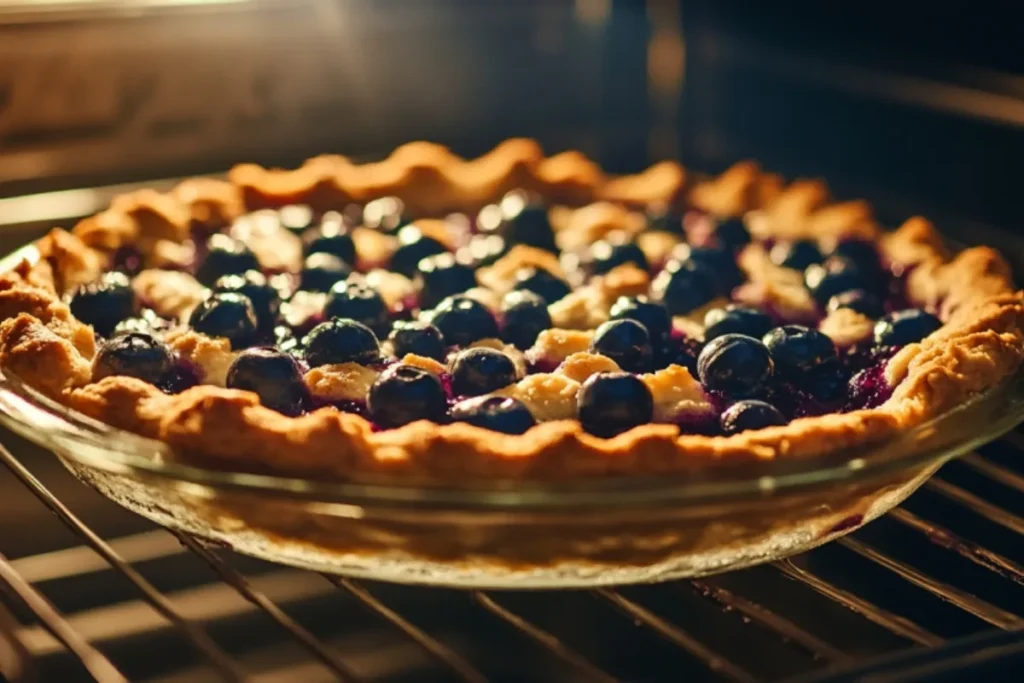
Cobbler dough should be your go-to for fruit desserts where you want a rustic, homemade feel and a quick preparation. If you’re in the mood for something light and fluffy on top of your fruit filling, cobbler dough is the ideal choice.
On the other hand, if you’re making a more elegant pie and prefer a flaky, buttery crust that wraps around the fruit filling, pie crust is the better option. Pie crust is perfect for traditional fruit pies and is typically used when you need a firmer, more structured layer that provides a contrasting texture to the juicy fruit inside.
Why is My Cobbler Soggy?
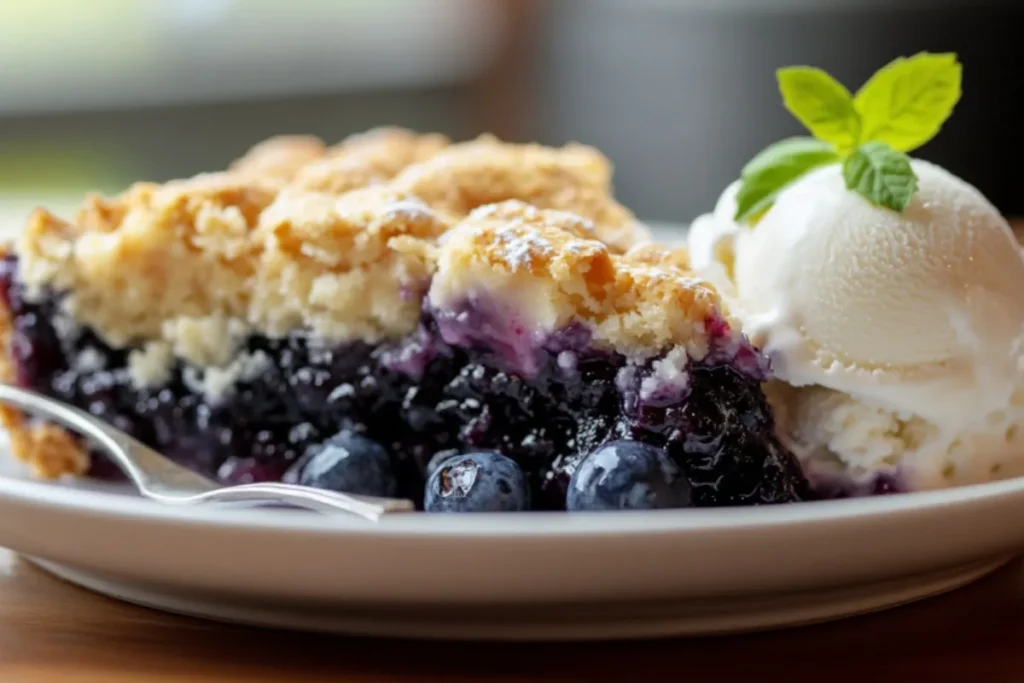
Common Causes of a Soggy Cobbler
If your cobbler ends up soggy, there are a few common culprits that might be to blame. The first issue could be using too much fruit or not draining the fruit properly. Excess moisture from the fruit can seep into the dough, causing it to become soggy.
Another factor is using too much liquid in the topping. While cobbler dough can handle some moisture from the fruit, too much liquid can overwhelm it, preventing the dough from baking to a crisp texture.
Lastly, underbaking can lead to a soggy cobbler. If the cobbler isn’t baked long enough, the dough won’t have time to fully cook and form that golden, crisp topping.
To prevent sogginess, be sure to balance the moisture levels in your dessert. Many factors influence the texture and quality of fruits we use in our baking, and as Healthline.com points out, understanding fruit nutrition is crucial for achieving the best results in your recipes. For another fruit-based dessert that maintains the perfect texture, check out Baked Apple Fritters Recipe. They deliver a crispy bite while still using juicy apples for flavor.
To prevent sogginess, be sure to balance the moisture levels in your dessert. For another fruit-based dessert that maintains the perfect texture, check out Baked Apple Fritters Recipe. They deliver a crispy bite while still using juicy apples for flavor.
How to Prevent a Soggy Bottom in Cobbler
To prevent a soggy cobbler, start by using the correct ratio of fruit to dough. Ensure that your fruit is not overly juicy, and if necessary, drain off any excess liquid before adding it to the baking dish.
For the dough, make sure it’s thick enough to support the fruit without becoming overwhelmed. Adding a bit of flour or cornstarch to the fruit filling can help absorb excess moisture and thicken the juices as it bakes.
Finally, be sure to bake the cobbler for the right amount of time. Depending on the size of your cobbler and the temperature of your oven, it may take anywhere from 35 to 50 minutes to fully bake. You’ll know it’s done when the top is golden brown, and a toothpick inserted into the dough comes out clean.
FAQs
What is the difference between blueberry crumble and blueberry cobbler?
The main difference between blueberry crumble and blueberry cobbler is the topping. Crumble has a streusel-like topping made from butter, sugar, and flour (often with oats or nuts), giving it a crunchy texture. In contrast, blueberry cobbler features a biscuit-like topping, which is often softer and fluffier. The fillings are quite similar, with both using fresh fruit, but the texture of the topping is what distinguishes them.
What is the difference between apple cobbler and apple crumble?
Similar to blueberry crumble and cobbler, the difference between apple cobbler and apple crumble lies in the topping. Apple cobbler uses a biscuit or dough-like topping, which is soft and thick, while apple crumble has a crunchy, streusel-style topping made from butter, sugar, and flour (often with added oats). Both desserts use apples as the base fruit, but the textures and overall eating experience differ.
Is cobbler dough the same as pie crust?
No, cobbler dough is not the same as pie crust. Cobbler dough is typically thicker and more biscuit-like, using baking powder as a leavening agent, which gives it a light, fluffy texture. On the other hand, pie crust is made with flour, butter, and water, creating a flaky and crisp texture. Cobbler dough is often spooned onto the fruit filling, while pie crust is typically rolled and used for both the top and bottom of a pie.
How do I make sure my cobbler is not soggy?
To prevent a soggy cobbler, ensure that your fruit isn’t overly juicy. Drain the fruit if necessary, and make sure to use a proper balance of liquid in the topping. Baking the cobbler for the right amount of time is essential—underbaking can cause the dough to remain soft and soggy. You should aim for a golden-brown topping and a fruit filling that’s bubbling.
Can I substitute other fruits in a blueberry cobbler?
Absolutely! While blueberries are the classic choice, you can substitute a variety of fruits in your cobbler, depending on the season and your preference. Try using peaches, blackberries, cherries, or apples. You can also mix fruits to create a mixed berry cobbler or stone fruit cobbler. Keep in mind that some fruits may release more juice than others, so adjust the amount of sugar or thickening agents accordingly.
Can I make a healthier version of blueberry cobbler?
Yes, you can make a healthier version of blueberry cobbler by making a few substitutions:
- Use whole wheat flour instead of all-purpose flour for the topping.
- Swap out butter for coconut oil or Greek yogurt.
- Reduce the amount of sugar or use a natural sweetener like honey or maple syrup.
- For a lower-calorie option, use a mix of fresh fruit and a lighter topping or make a crumble with less sugar and butter.
Can I prepare blueberry cobbler ahead of time?
Yes, blueberry cobbler can be prepared ahead of time. You can assemble the fruit filling and topping separately and store them in the fridge. When you’re ready to bake, simply add the topping to the filling and bake as usual. Alternatively, you can fully bake the cobbler and store it in the fridge for a few days. Reheat it in the oven to restore its crispy top and warm, bubbling filling.

